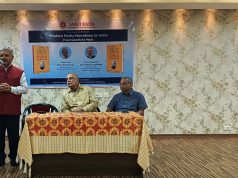
While the world is gearing up to welcome yet another year, two ancient cities, which have lots in common in terms of travails and trauma they have suffered, are undergoing civilisational trials
While the world is busy getting ready to welcome 2018, two ancient cities — Ayodhya and Jerusalem — have been in the news for civilisational reasons in the last month of the outgoing year. Jerusalem, the focus and spiritual centre of the Jews, hit the headlines when the Trump Administration decided to shift the US embassy in Israel there from its current location in Tel Aviv.
Ayodhya, one of the holiest cities of Hindus, figured in public discourse recently after the Supreme Court decided to hear the Babri Masjid-Ram Janam Bhumi case. Appeals against the Allahabad High Court verdict in this case have been pending before the apex court for the last seven years.
Both Ayodhya and Jerusalem, located in two different parts of the globe, have a lot in common in terms of travails and the trauma they have suffered at the hands of successive invaders, who claimed divine inspiration from their respective religious texts while repeatedly sacking the ancient cities.
Like Ayodhya, whose existence pre-dates even Lord Rama, the history of Jerusalem too is lost in antiquity, tracing its hoary past to Adam, the first man created by god. It is believed that Adam lived in Jerusalem all of his life.
During its chequered history, Jerusalem has been attacked 52 times, captured, and recaptured 44 times, besieged 23 times and destroyed twice. In the 1st century CE, Jerusalem became the birthplace of early Christianity. The Emperor Constantine developed the city as a Christian centre of worship and the Jews were banned from their city.
In 638 CE, the city was over-run by Muslims, led by their first Caliph Umar ibn Al-Khattab. However, in July 1099, crusaders captured the city and nearly all the Muslim and Jewish inhabitants were massacred. In 1517, Jerusalem was taken over by the Ottoman empire and after its collapse, by the British.
The way the name of Lord Rama (and by association that of Ayodhya) permeates India and Hindus the world over, the city of Jerusalem is central to the faith and identity of Jews. Here are some Jewish customs.
A tiny amount of ash is touched to the forehead of a Jewish groom before he goes to stand beneath the bridal canopy. This symbolically reminds him not to allow his own rejoicing to be greater than the ongoing need to recall Jerusalem’s repeated destruction.
Another ancient custom is to leave a path of interior wall opposite the door to one’s home unpainted, as a remembrance of the destruction of the temples and city of Jerusalem at the hands of successive invaders.
According to the Bible, Jewish temples stood on Temple Mount. According to Jewish tradition and scripture, the first temple was built by King Solomon, the son of King David, in 957 BCE and destroyed by the Babylonians in 586 BCE. The second was constructed under the auspices of Zerubbabel in 516 BCE and destroyed by the Roman Empire in 70 CE. Jewish tradition maintains it is here that a third and final temple will also be built.
The location is the holiest site in Judaism and is the place Jews turn towards during prayer. Due to its extreme sanctity, many Jews will not walk on the Mount itself, to avoid unintentionally entering the area where the Holy of Holies stood, since according to Rabbinical law, some aspect of the divine presence is still present at the site.
However, after Islamic take-over in 638 CE, the Mount was declared the third holiest site for Sunni Muslims. It is revered as the Noble Sanctuary, the location of Prophet Muhammad’s journey to Jerusalem and ascent to heaven.
The Prophet is believed to have been taken by the miraculous Steed, Buraq, to visit Jerusalem, where he prayed and then to visit heaven, in a single night in the year 610.
While the Hindus are repeatedly told to prove Lord Rama’s birthplace at Ayodhya, none has ever asked for evidence for the Islamic belief about the Prophet’s sojourn to heaven on a flying horse.
Thanks to their steadfast commitment to their culture and faith, unity, and clarity of purpose, the Jews today have complete control over Jerusalem. On the other hand, divided Hindus have been struggling to build a Ram temple at his birth place for hundreds of years, but without any tangible results.
The Hindu aspiration to build a grand Ram temple, at the site believed to be his birth place in Ayodhya, is not directed against Islam or Muslims. What the Karsevaks demolished on December 6, 1992, was not a place of worship (a mosque) but a monument built by an invader to humiliate the locals. The situation is best summed up in the words of Arnold Toynbee, one of the great historians of the present century. While delivering the Azad Memorial Lecture, he said:
“As I have been speaking, some vivid visual memories have been flashing up in my mind’s eye. One of these is a mental picture of the principal square in the Polish City of Warsaw sometime in the late nineteen twenties. In the course of the first Russian occupation of Warsaw (1614-1915) the Russians had built an Eastern Orthodox Christian Cathedral on this central spot in the city that had been the capital of the once independent Roman Catholic Christian country, Poland.
“The Russians had done this to give the Poles a continuous ocular demonstration that the Russians were now their masters. After the reestablishment of Poland’s independence in 1918, the Poles had pulled this cathedral down. Demolition had been completed just before the date of my visit. I do not greatly blame the Polish Government for having pulled down that Russian Church. The purpose for which the Russians had built it had been not religious but political, and the purpose had also been intentionally offensive.
“Aurangzeb’s purpose in building those three Mosques was the same intentionally offensive political purpose that moved the Russians to build their Orthodox Cathedral in the city centre at Warsaw. Those three Mosques were intended to signify that an Islamic Government was reigning supreme, even over Hinduism’s holiest of holy places.
“I must say that Aurangzeb had a veritable genius for picking out provocative sites. Aurangzeb and Philip II of Spain are a pair. They are incarnations of the gloomily fanatical vein in the Christian-Muslim-Jewish family of religions.
“Aurangzeb — a poor wretched misguided bad man spent a lifetime of hard labour in raising massive monuments to his own discredit. Perhaps the Poles were really kinder in destroying the Russians self-discrediting monuments in Warsaw than you have been in sparing Aurangzeb’s Mosques. Anyway, it is Aurangzeb, and not the Hindu holy ground on which his Mosques are planted, that suffers from their very conspicuous presence…” (One World and India, compiled by National Book Trust, pp 59-61)
By Balbir Punj
(The writer is a political commentator and a former BJP Rajya Sabha MP)
Courtesy: Daily Pioneer














